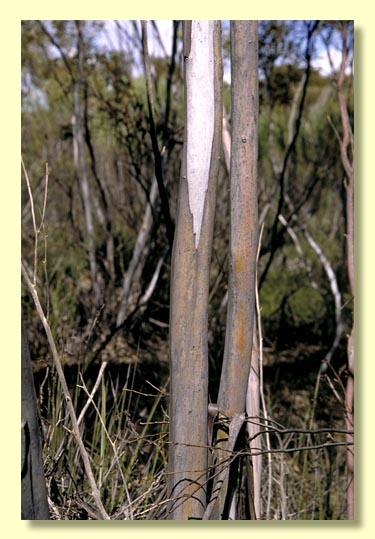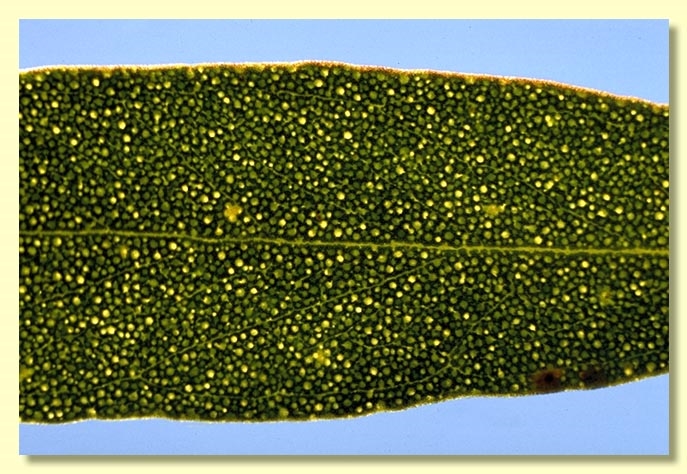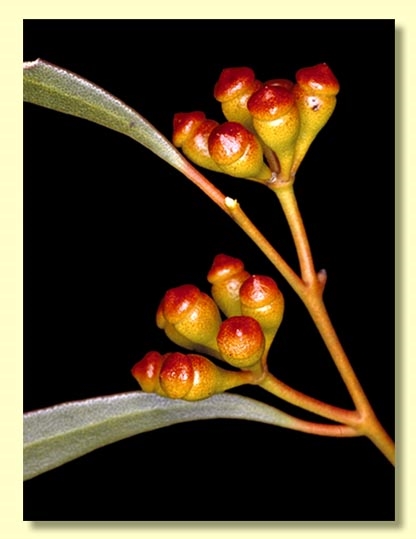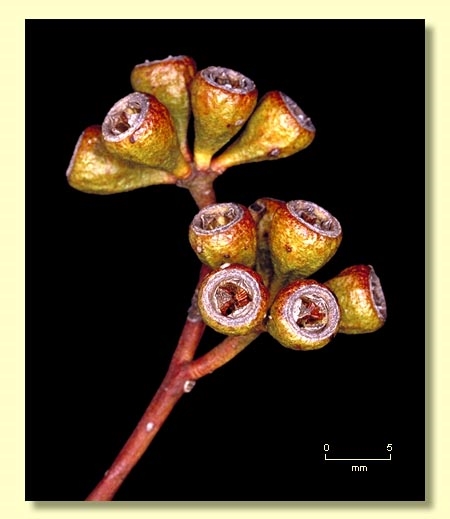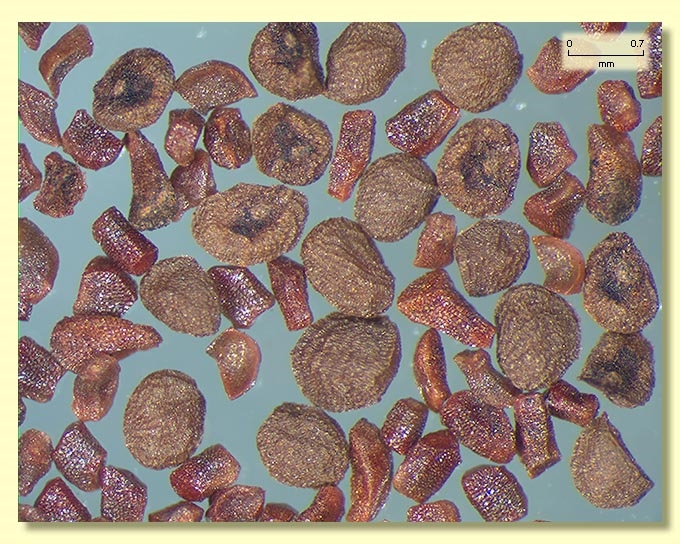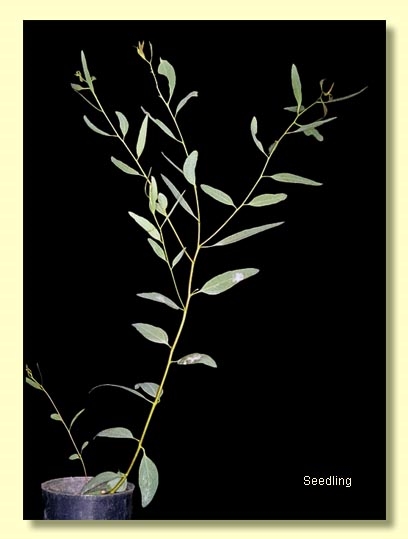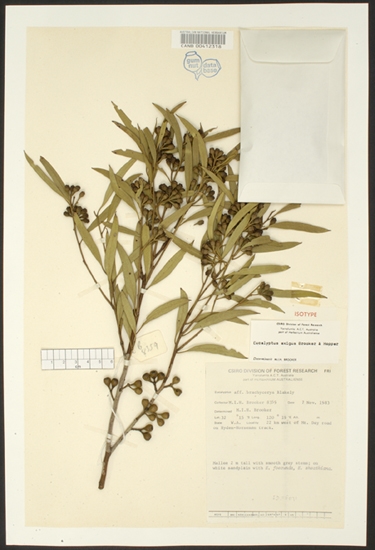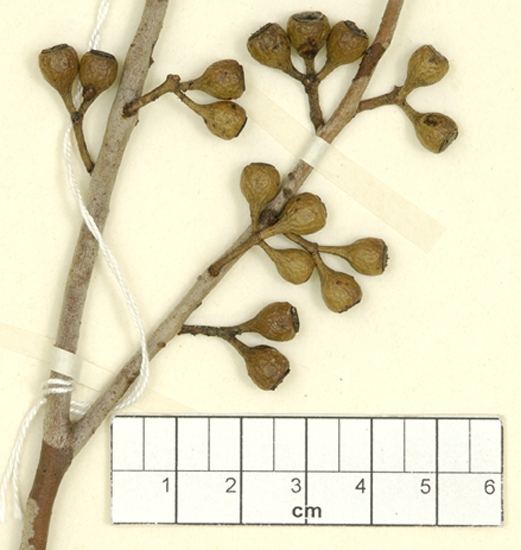Eucalyptus | Symphyomyrtus | Dumaria | Ovulares
Euclid - Online edition
Eucalyptus exigua
Bark smooth throughout, whitish grey.
Branchlets with a few pith oil glands but sometimes small and difficult to find.
Juvenile growth (coppice or field seedlings to 50 cm): stems rounded in cross-section; juvenile leaves always petiolate, alternate, narrowly elliptical to lanceolate, 3.5–6 cm long, 0.7–1.5 cm wide, dull, bluish green.
Adult leaves alternate, petioles 0.5–1.7 cm long; blade linear to narrowly lanceolate, 4–9 cm long, 0.5–1.3 cm wide, base tapering to petiole, margin entire, apex pointed, concolorous, dull to slightly glossy, green, acute side-veins present or all venation except midrib obscured by numerous round oil glands.
Inflorescence axillary unbranched, peduncles 0.5–1.5 cm long, buds 7, 9 or 11 per umbel, pedicels short and stout, 0.3–0.5 cm long. Mature buds more or less cylindrical (0.6–0.7 cm long, 0.4–0.5 cm wide), always with a constriction at join of hypanthium and operculum, scar present, operculum flattened with a conspicuous but short beak or an apiculum, stamens inflexed, anthers oblong, versatile, dorsifixed, dehiscing by longitudinal slits, style long and straight, stigma broadly rounded, locules 4, the placentae each with 4 vertical rows of ovules. Flowers white.
Fruit pedicellate (pedicels 0.3–0.5 cm long), shortly barrel-shaped to obconical, 0.5–0.7 cm long, 0.5–0.8 cm wide, disc descending, valves 4, at rim level.
Seeds mid-brown, 0.5–1.5 mm long, flattened-ovoid, dorsal surface shallowly and clearly reticulate, hilum ventral.
Cultivated seedlings (measured at node 10): cotyledons oblong-reniform; stems rounded in cross-section; leaves always petiolate, opposite for 4 to 6 nodes then alternate, lanceolate to narrowly so, 4.5–6 cm long, 0.8–1.5 cm wide, dull green to grey-green.
Flowering time unknown.
A spindly mallee species endemic to Western Australia, occurring in the general area of the Hyden Scrub from the Forrestania Cross-roads east towards Mt Day, but it is not common. It has smooth bark, glossy green crown and beaked buds with a constriction at the base of the operculum.
Eucalyptus exigua belongs in Eucalyptus subgenus Symphyomyrtus section Dumaria because the buds have two opercula, stamens are strongly inflexed, ovules are in four rows on the placentae and cotyledons are reniform. Within section Dumaria it belongs to a small subgroup of nine closely related species which are together called series Ovulares. The series is further diagnosed by glandular pith, cuboid anthers, and seeds with a brown shallowly and clearly reticulate dorsal seed coat.
Some of the species in series Ovulares are completely smooth-barked (E. cyclostoma, E. cylindrocarpa, E. exigua and smaller plants of E. oraria) while others (E. aequioperta, E. baudiniana, E. comitae-vallis, E. myriadena and E. ovularis) have rough bark over at least part of the stems.
E. exigua is closest to E. comitae-vallis and E. cyclostoma, which also have buds constricted at the join of operculum and hypanthium. It differs from both of these in its smaller stature and smaller buds and fruit. Geographically E. exigua occurs between these two species.


